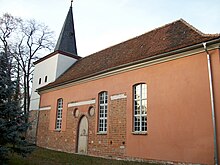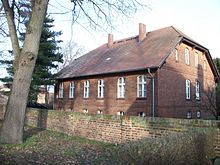Networks
|
Networks
Lehnin monastery community
Coordinates: 52 ° 20 ′ 30 ″ N , 12 ° 41 ′ 9 ″ E
|
|
|---|---|
| Height : | 27 m above sea level NN |
| Residents : | 686 (Jan. 1, 2011) |
| Incorporation : | April 1, 2002 |
| Postal code : | 14797 |
| Area code : | 03382 |
Netzen was an independent municipality in the Amt Lehnin until 2002 , since then it has been part of the municipality of Kloster Lehnin in the Potsdam-Mittelmark district of the state of Brandenburg .
location
Netzen is located northwest of Lehnin near the A2 and is part of the historic Brandenburg landscape of Zauche . The state road 88 leads through the village. To the east of the village is the Netzener See.
history
The original of the first mention of nets has not survived. A copy from the 15th century shows that the provost Heinrich of the Brandenburg cathedral chapter transfers the property of a mill to his chaplain Burchardi, who was also a pastor in Netzen, as a fiefdom in "Nydecem" (Netzen). The copy does not contain any dates, the reign of the Provost is closed to 1190.
Until 1241, Netzen was part of the Brandenburg Cathedral Chapter. The margraves Johann and Otto sold 13 hooves in nets in 1241 to the Lehnin monastery , which in 1244 also received the patronage and the school administration in nets with the associated hooves. The margraves Johann and Otto finally sold nets to the Lehnin monastery in 1252.
The written mention of the village and the Slavic place name indicate that there was both a Slavic settlement and a parish of German colonists in nets around 1200 .
Netzen was the property of this monastery until the Lehnin monastery was dissolved in 1542. From 1542 to 1872, Netzen was the official village of the royal domain office in Lehnin .
At the end of the 12th century there was already a parish in nets with Pastor Burchardi. A new church was built at the end of the 14th century as a late Gothic brick building with a late medieval church tower made of field stones in the lower area. The upper part of the tower is made of clay framework . The tower roof consists of an octagonal slated pointed helmet placed in the middle . Around 1450, Netzen is the mother church with the Grebs and Nahmitz branches .
During the Thirty Years' War , Netzen was plundered in 1630 by the imperial lieutenant colonel Adam Georg von Putlitz. Around 1631 the rectory and its farm buildings were destroyed.
The number of inhabitants only increased significantly again in the 18th century, so that a new school building was necessary in 1776/77. Simple field kilns for brick production were built in 1783.
In the 19th century, brick production in two brick factories brought an economic boom. The Emster Canal was built in 1871 as a transport route for the bricks . The rapid increase in the population in nets required the school to be rebuilt in 1855, followed by a second schoolhouse in 1898. In 1895 the new building of the rectory is recorded.
At the end of the 19th and beginning of the 20th century, diverse and lively club life began in networks. There were a number of small craft shops and restaurants.
The agriculture was run in nets in family businesses until after the two world wars. In 1953, the new agricultural policy led to a wave of farmers fleeing to the Federal Republic of Germany . The abandoned farms were merged into a local agricultural enterprise (ÖLB), from which the LPG emerged in 1955 . An agricultural cooperative has existed since 1990 .
Culture and sights
The Rietzer See nature reserve is a breeding ground for rare and threatened bird species. As a special feature of the protected area, there are some very rare inland salt sites on the north shore of Lake Netzen and unique salt marshes . A circular route of approx. 2.5 km in length runs as a nature trail between Netzen, Lake Netzen and the bridge on the Emster Canal. In the nature reserve there is a bird observation tower and a natural swimming area on Lake Netzen. The Netzener Landfrauen, as part of the Kreislandfrauenverband Potsdam-Mittelmark, contributes to the enrichment of cultural and community life in Kloster Lehnin through a variety of activities . The place of activity is the multigenerational house.
literature
- Brigitte Pietzner: "Chronicle of a village Netzen ... 1190–2008", (published by the municipality of Kloster Lehnin / OT Netzen 2008)
- Adolph Friedrich Riedel: Codex Diplomaticus Brandenburgensis , Berlin 1838–1869, Volume AX, p. 202 and p. 207
Web links
- The place on the website of the municipality of Kloster Lehnin
- Contribution to the RBB program Landschleicher on October 17, 2010
Individual evidence
- ↑ Brigitte Pietzner: “Chronicle of a village nets… 1190–2008”, p. 25f.
- ^ Adolph Friedrich Riedel: Codex Diplomaticus Brandenburgensis , Berlin 1838–1869, Volume AX, p. 202 and p. 207.
- ↑ Brigitte Pietzner: “Chronicle of a village nets… 1190–2008”, p. 154.
- ↑ Brigitte Pietzner: “Chronicle of a village nets… 1190–2008”, p. 130f.
- ↑ Brigitte Pietzner: “Chronicle of a village nets… 1190–2008”, p. 56f.


